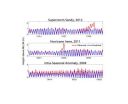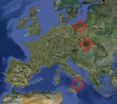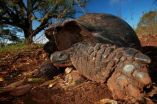(Press-News.org) Uncertainty about how much the climate is changing is not a reason to delay preparing for the harmful impacts of climate change says Professor Jim Hall of the Environmental Change Institute at the University of Oxford and colleagues at the Tyndall Centre for Climate Change Research, writing today in Nature Climate Change.
The costs of adapting to climate change, sea-level and flooding include the upfront expenses of upgrading infrastructure, installing early-warning systems, and effective organisations, as well as the costs of reducing risk, such as not building on flood plains.
Robert Nicholls, Professor of Coastal Engineering at the University of Southampton and the Tyndall Centre for Climate Change Research, says: "Some impacts of climate change are now inevitable, so it is widely agreed that we must adapt. But selecting and funding adaptation remains a challenge."
Professor Nicholls and his co-authors describe two ways of assessing how much adaptation to climate change is enough by balancing the risk of climate change against the cost of adaptation. First they describe cost-benefit analysis where the cost of the adaptation has to be less than the benefit of risk reduction. Alternatively, decision makers can seek the most cost-effective way of maintaining a tolerable level of risk. This approach is easier for policymakers to understand, but thresholds of tolerable risk from climate change are not well defined.
The Thames Estuary Gateway is the only place in the UK where a level of protection against flooding is defined in law – a 1 in 1000 year standard of protection which needs to be maintained with rising sea levels. The authors conclude that adaptation decisions need exploration across a variety of different interpretations of risk, not a single answer.
"Like all complex problems several perspectives are needed and any single answer would misrepresent the uncertainty, but let us not let paralysis by analysis be an obstacle to action on adaptation," says Professor Hall.
"Adaptation decisions have further benefits. The tenfold increase in the Netherlands standard of flood protection proposed in 2008 has sent a message to global business that the Netherlands will be open in the future, come what may," adds Professor Nicholls.
The research article 'Proportionate adaptation' by Professor Jim Hall (Oxford University), Dr Sally Brown (University of Southampton), Professor Robert Nicholls (University of Southampton), Professor Nick Pidgeon (Cardiff University) and Professor Robert Watson (University of East Anglia) is published in Nature Climate Change December 2012. All of the authors are members of the Tyndall Centre for Climate Change Research.
INFORMATION:
Paralysis by analysis should not delay decisions on climate change
2012-11-27
ELSE PRESS RELEASES FROM THIS DATE:
Researcher studies 'middle ground' of sea-level change
2012-11-27
The effects of storm surge and sea-level rise have become topics of everyday conversation in the days and weeks following Hurricane Sandy's catastrophic landfall along the mid-Atlantic coast.
Ongoing research by professor John Brubaker of the Virginia Institute of Marine Science is throwing light on another, less-familiar component of sea-level variability—the "intra-seasonal" changes that occupy the middle ground between rapid, storm-related surges in sea level and the long-term increase in sea level due to global climate change.
"These are cases when the water is ...
From Mediterranean coasts to Tatra Mountains and beyond: Plant chromosome number variation
2012-11-27
Chromosome number is the most basic feature concerning the genome of a species, and it is known for about one third of higher plant species. In particular, for plants of Italy, Slovakia, and Poland, online chromosome number databases have been developed: 'Chrobase.it – Chromosome numbers for the Italian flora', 'Karyological database of ferns and flowering plants of Slovakia' and 'Chromosome number database – PLANTS', respectively. The three datasets account for about 35%, 60% and 40% of the whole floras, respectively.
"We used these datasets to compare chromosome number ...
Researchers explore social media as preventative method for infectious diseases
2012-11-27
MANHATTAN, Kan. -- When it comes to stopping illness, social media posts and tweets may be just what the doctor ordered.
A Kansas State University-led research team is looking at social media as a tool to reduce and prevent diseases from spreading. Researchers are studying whether a well-timed post from a public authority or trustworthy person could be as beneficial as flu shots, hand-washing or sneezing into an elbow.
"Infectious diseases are a serious problem and historically have been a major cause of death," said Faryad Sahneh, Kansas State University doctoral candidate ...
Man's best friend: Common canine virus may lead to new vaccines for deadly human diseases
2012-11-27
Athens, Ga. – Researchers at the University of Georgia have discovered that a virus commonly found in dogs may serve as the foundation for the next great breakthrough in human vaccine development.
Although harmless in humans, parainfluenza virus 5, or PIV5, is thought to contribute to upper respiratory infections in dogs, and it is a common target for canine vaccines designed to prevent kennel cough. In a paper published recently in PLOS ONE, researchers describe how this virus could be used in humans to protect against diseases that have eluded vaccine efforts for decades.
"We ...
Galapagos tortoises are a migrating species
2012-11-27
This press release is available in German.
The Galapagos giant tortoise, one of the most fascinating species of the Galapagos archipelago, treks slowly and untiringly across the volcanic slopes. Scientists of the Max Planck Institute for Ornithology in Radolfzell, together with the Charles Darwin Foundation, have used GPS technology and modern 3D acceleration measurements to find out that especially the dominant male tortoise wanders up to 10 kilometres into the highlands of the island. Only the fully grown animals migrate, the young tortoises stay year round in ...
Do missing Jupiters mean massive comet belts?
2012-11-27
Using ESA's Herschel space observatory, astronomers have discovered vast comet belts surrounding two nearby planetary systems known to host only Earth-to-Neptune-mass worlds. The comet reservoirs could have delivered life-giving oceans to the innermost planets.
In a previous Herschel study, scientists found that the dusty belt surrounding nearby star Fomalhaut must be maintained by collisions between comets.
In the new Herschel study, two more nearby planetary systems – GJ 581 and 61 Vir – have been found to host vast amounts of cometary debris.
Herschel detected ...
Researchers study cry acoustics to determine risk for autism
2012-11-27
Autism is a poorly understood family of related conditions. People with autism generally lack normal social interaction skills and engage in a variety of unusual and often characteristic behaviors, such as repetitive movements. While there is no specific medical treatment for autism, some success has been shown with early behavioral intervention.
Understanding the importance of early diagnosis, researchers at Women & Infants' Brown Center for the Study of Children at Risk in collaboration with researchers at University of Pittsburgh have been studying the cry acoustics ...
Flu outbreaks predicted with weather forecast techniques
2012-11-27
Contact: David Hosansky
hosansky@ucar.edu
303-497-8611
Zhenya Gallon
zhenya@ucar.edu
303-497-8607
National Center for Atmospheric Research/University Corporation for Atmospheric Research
Flu outbreaks predicted with weather forecast techniques
BOULDER – Scientists at Columbia University and the National Center for Atmospheric Research have adapted techniques used in modern weather prediction to generate local forecasts of seasonal influenza outbreaks. By predicting the timing and severity of the outbreaks, this system can eventually help health officials ...
Cell Transplantation reports islet cell advancement increases impact on transplantation
2012-11-27
Putnam Valley, NY. (Nov. 27, 2012) – A study published in the current issue of Cell Transplantation (21:8), now freely available on-line at http://www.ingentaconnect.com/content/cog/ct/ , reports that a team of researchers in South Korea have successfully engineered islet cell clusters (ICCs) that will improve pancreatic islet transplantation and offer promise for curing diabetes mellitus.
Carried out by collaborating researchers at three universities in Seoul, Korea, the new process of creating ICCs included delivering a gene to single islet cells that increased their ...
An energy conscious workforce: New research looks at how to encourage staff to go green
2012-11-27
As homeowners we are becoming cannier about turning down the thermostat to save our pennies and the planet but are we as energy conscious when we get to work?
A new £1.3m project, being led by researchers at The University of Nottingham, is to look at people's attitudes to energy consumption in the workplace and how to encourage colleagues to work together in reducing their organisation's carbon footprint.
Drawing on technical expertise at Nottingham's Horizon Digital Economy Research and design skills of experts at The University of Southampton, the five-year study ...





